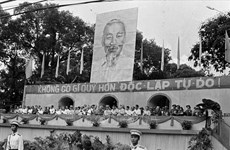Genocide museum gets help to preserve archive heritage
The UN Educational, Scientific and
Cultural Organisation (UNESCO) said it will assist Cambodia ’s Tuol
Sleng Genocide Museum in preserving historical documents on torture and
killing carried out by the Khmer Rouge regime during 1975 to 1979.
The UN Educational, Scientific and
Cultural Organisation (UNESCO) said it will assist Cambodia ’s Tuol
Sleng Genocide Museum in preserving historical documents on torture and
killing carried out by the Khmer Rouge regime during 1975 to 1979.
The documents and photographs currently kept at the museum have been listed on the UNESCO Memory of the World Register.
According to the UNESCO Office in Phnom Penh , a decision was made to preserve the site to help younger Cambodian generations understand more about the country’s history and remind the world of the genocide that took place there.
The museum used to be a high school but was turned into a prison known as S-21 for almost five years during the rule of Democratic Kampuchea regime from 1975-1979. Its archives include various documents showing the fate of over 15,000 prisoners who were held at the former high school from 1975-1979. Almost of them were then killed in Chang Ek, known as the “Killing Field” on the outskirts of Phnom Penh .
These archives constitute the most complete existing documentary picture of the Democratic Kampuchea prison system, a fundamental part of the regime under which about 2-3 million people (25-30 percent of the population) lost their lives in a period of three years, 8 months and 20 days./.
The documents and photographs currently kept at the museum have been listed on the UNESCO Memory of the World Register.
According to the UNESCO Office in Phnom Penh , a decision was made to preserve the site to help younger Cambodian generations understand more about the country’s history and remind the world of the genocide that took place there.
The museum used to be a high school but was turned into a prison known as S-21 for almost five years during the rule of Democratic Kampuchea regime from 1975-1979. Its archives include various documents showing the fate of over 15,000 prisoners who were held at the former high school from 1975-1979. Almost of them were then killed in Chang Ek, known as the “Killing Field” on the outskirts of Phnom Penh .
These archives constitute the most complete existing documentary picture of the Democratic Kampuchea prison system, a fundamental part of the regime under which about 2-3 million people (25-30 percent of the population) lost their lives in a period of three years, 8 months and 20 days./.












